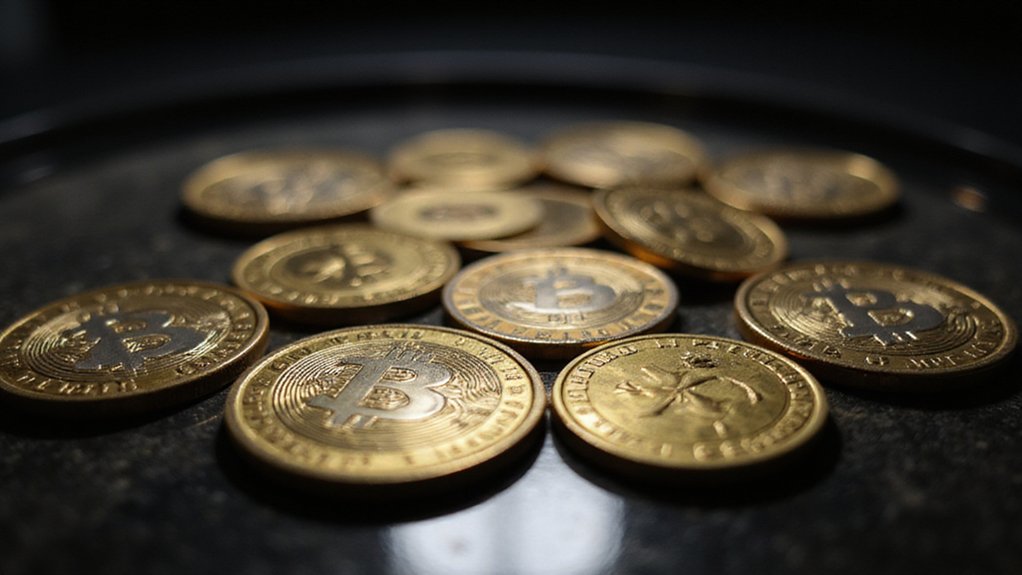The altcoin market represents thousands of alternative cryptocurrencies born from Bitcoin’s shortcomings—sluggish transaction speeds, energy consumption rivaling small nations, and scalability constraints that would make a dial-up modem blush. These digital alternatives, from Ethereum’s smart contracts to Monero’s privacy features and stablecoins pegged to traditional currencies, promise technological salvation while delivering notorious volatility that exceeds even the most unpredictable equities. Navigate this landscape with proper due diligence, and the complexities become considerably more manageable.

Why would anyone venture beyond Bitcoin into the sprawling wilderness of alternative cryptocurrencies when the original digital asset already presents enough complexity to confound seasoned investors? The answer lies partly in Bitcoin’s inherent limitations—sluggish transaction speeds, scalability constraints, and energy consumption that would make a small nation blush—and partly in humanity’s perpetual quest to reinvent perfectly functional wheels.
Altcoins, a portmanteau of “alternative” and “coin,” emerged in 2011 as developers attempted to address Bitcoin’s shortcomings while introducing novel functionalities. These digital descendants range from Ethereum’s smart contract capabilities (enabling decentralized applications that may or may not revolutionize finance) to Monero’s privacy-focused architecture, which appeals to users seeking transaction anonymity for reasons both legitimate and otherwise. Some altcoins originated from Bitcoin hard forks, creating entirely new cryptocurrencies like Bitcoin Cash that maintain certain core characteristics while implementing different features.
The altcoin ecosystem encompasses thousands of cryptocurrencies, each promising unique value propositions. Stablecoins like USDT and USDC attempt to solve volatility through fiat currency pegging—a somewhat ironic solution given cryptocurrency’s original anti-establishment ethos. Meanwhile, second and third-generation altcoins like Ethereum and Litecoin have introduced technological innovations that occasionally justify their existence beyond mere speculation.
Market dynamics reveal altcoins’ notorious volatility, with price fluctuations that make traditional equities appear sedately predictable. Investment risks escalate considerably compared to Bitcoin, as newer projects lack established track records and face regulatory uncertainties that vary dramatically across jurisdictions. The sheer volume of emerging altcoins creates a paradox of choice where due diligence becomes both essential and practically impossible.
Trading occurs primarily through cryptocurrency exchanges like Gate.io and Changelly, platforms that charge varying fees while implementing security measures of questionable effectiveness (as numerous hacking incidents have demonstrated). After selecting a reputable exchange, investors must navigate the complexities of order placement, fee structures, and security protocols that can overwhelm newcomers to the space. Successful altcoin investing requires thorough research, technical analysis, and risk management strategies that extend beyond blind faith in revolutionary blockchain applications.
Portfolio diversification represents altcoins’ primary appeal for rational investors, offering exposure to emerging technologies while spreading risk across multiple assets. However, this diversification strategy assumes altcoins won’t collectively crater during market downturns—an assumption that historical precedent suggests may be optimistically naive. The altcoin market ultimately rewards those who combine technological understanding with healthy skepticism about humanity’s latest financial innovations.
Frequently Asked Questions
How Do I Calculate Taxes on Altcoin Trading Profits and Losses?
Calculating altcoin trading taxes requires meticulous record-keeping of each transaction’s cost basis, sale price, and holding period.
Traders must report gains and losses on Schedule D and Form 8949, treating each trade as a taxable event.
Short-term trades (under one year) face ordinary income rates, while long-term holdings qualify for preferential capital gains treatment.
Deducting transaction fees from proceeds while adding them to cost basis optimizes calculations—assuming one bothers tracking such minutiae.
Which Cryptocurrency Exchanges Offer the Best Security for Altcoin Storage?
Gemini and Coinbase lead security rankings through FDIC insurance and 98% cold storage respectively, while Kraken’s encryption protocols and WhiteBIT’s AAA CER.live rating demonstrate institutional-grade protection.
Binance’s SAFU fund and Crypto.com’s ISO 27001 certification provide additional safeguards.
Given altcoin trading’s tax complexities (as previously discussed), choosing exchanges with thorough insurance—covering both regulatory compliance and asset protection—becomes particularly vital for maintaining auditable transaction records.
What Are the Warning Signs of Altcoin Pump and Dump Schemes?
Investors should scrutinize sudden price spikes accompanied by coordinated social media campaigns from unverified accounts promising astronomical returns—because nothing screams legitimacy quite like anonymous promoters urging immediate action.
Low-cap altcoins experiencing unusual trading volumes while backed by teams offering vague project details represent classic manipulation targets.
The telltale combination of artificial urgency, fake celebrity endorsements, and identical promotional messages across multiple platforms typically precedes the inevitable dump phase that leaves retail investors holding worthless tokens.
How Much Should Beginners Invest in Altcoins Versus Bitcoin Initially?
Beginners should embrace the core-satellite approach: allocate 70-90% to Bitcoin’s relative stability, reserving 10-30% for altcoin speculation.
This allocation acknowledges Bitcoin’s market dominance and liquidity advantages while permitting calculated exposure to altcoins’ higher upside potential.
Given the pump-and-dump schemes previously discussed, novices benefit from Bitcoin’s lower volatility as their foundation.
Position sizing becomes essential—one can hardly expect beginner investors to navigate altcoin turbulence without established risk management fundamentals.
What Tools Help Track Altcoin Portfolio Performance Across Multiple Exchanges?
Portfolio tracking across multiple exchanges requires specialized tools that sync automatically with various platforms.
CoinStats supports 300+ exchanges while offering wallet functionality, CoinTracker integrates seamlessly with major platforms like Coinbase and MetaMask, and Koinly connects to over 700 exchanges including Binance and Kraken.
These platforms provide real-time analytics, tax reporting capabilities, and intuitive dashboards—because manually tracking dozens of micro-cap positions across scattered exchanges ranks among investing’s more masochistic pursuits.









